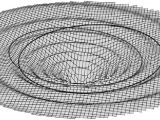Following the first studies of our galaxy, it was determined that it belonged to the spiral-arm class, and that it had two such formations orbiting its core. Work that was done later on disproved that hypothesis, and revealed that the Milky Way in fact sported four arms. The latter remained the norm for many years, but now a group of independent researchers is arguing that the first idea was right all along.
They add that the map of the galaxy may need to be redrawn, and offer options on how this could be achieved. Their work appears in the November 2009 issue of the respected scientific journal Proceedings of the Royal Society A, Softpedia is told via email.
Independent mathematician Charles Francis of Hastings, in the UK, and Ashland, Oregon-based amateur astronomer Erik Anderson believe that they may have found a solution to the 80-year-old problem of why spiral galaxies evolve their arms. They say that the Milky Way is a tightly wound, “grand design” two-armed spiral, and not a four-arm type as previously thought. The two were working on very different problems when they made the discovery. Anderson was, for instance, collecting data on more than 20,000 Milky Way stars, with clearly established positions and velocities.
Francis says that, by considering orbits to be precessing ellipses, a natural pattern emerges – that leads to spiral-shaped orbital alignments. The main reason for this, the experts say, is the mutual gravitation that naturally acts on the stars. Francis explains that the best way to describe the set-up is to liken it to a very large funnel with spiral grooves.
Only, instead of marbles, the grooves are populated with stars, which continuously roll inside until they themselves build enough momentum to escape the forces that keep them imprisoned. Some of the escaping stars gain enough speed to move away from the galactic core.
The two experts also explain why there is great stability in the spiral-arm design. They say that, as one arm accumulates stars, it starts exerting a stronger gravitational field all around it. The effect can be described as the grooves inside the funnel getting deeper and attracting even more stars, Francis and Anderson add. The structure is basically reinforced by the mutual gravity that occurs between the stars themselves, the group believes. In the case of Milky Way's “grand design,” interstellar gas has also contributed to the current appearance of the arms.
“The idea is so simple that I had initially rejected it. I thought that if it were right, it would already be known; but when I compared it to data, it worked straight away, giving a perfect fit,” Francis says. “It is a very nice paper with very good ideas and explanations for the kinematic structures we observe. It comes up with an elegant way of explaining the velocity distribution in the solar neighborhood,” Rainer Klement says of the work. The German space expert is based at the Max Planck Institute for Astronomy, in Heidelberg.
“It comes as a surprise to most people that galactic orbits of stars are still treated in textbooks using a model of epicycles introduced in the 1920s. Epicycles are generally believed to have been banished from astronomy over three hundred years ago, when Newton explained Kepler's discovery that planetary orbits are ellipses. In popular culture, ‘adding epicycles’ refers to the process of introducing fudges to make a theory fit data, when actually the theory needs to be replaced in its entirety,” Francis shares.

 14 DAY TRIAL //
14 DAY TRIAL // 

